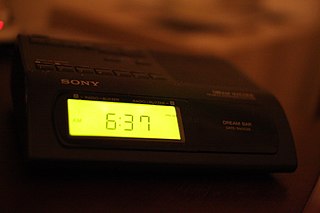
Alexander Graham Bell was a Scottish-born Canadian-American inventor, scientist and engineer who is credited with patenting the first practical telephone. He also co-founded the American Telephone and Telegraph Company (AT&T) in 1885.

Integrated Services Digital Network (ISDN) is a set of communication standards for simultaneous digital transmission of voice, video, data, and other network services over the digitalised circuits of the public switched telephone network. Work on the standard began in 1980 at Bell Labs and was formally standardized in 1988 in the CCITT "Red Book". By the time the standard was released, newer networking systems with much greater speeds were available, and ISDN saw relatively little uptake in the wider market. One estimate suggests ISDN use peaked at a worldwide total of 25 million subscribers at a time when 1.3 billion analog lines were in use. ISDN has largely been replaced with digital subscriber line (DSL) systems of much higher performance.

An alarm device is a mechanism that gives an audible, visual, combination, or other kind of alarm signal to alert someone to a problem or condition that requires urgent attention.

A police box is a public telephone kiosk or callbox for the use of members of the police, or for members of the public to contact the police. It was used in some countries, most widely in the United Kingdom throughout the 20th century from the early 1920s. Unlike an ordinary callbox, its telephone was located behind a hinged door so it could be used from the outside by anyone, and the interior of the box was, in effect, a miniature police station for use by police officers to read and fill in reports, take meal breaks and even temporarily hold detainees until the arrival of transport.
The public switched telephone network (PSTN) is the aggregate of the world's telephone networks that are operated by national, regional, or local telephony operators. It provides infrastructure and services for public telephony. The PSTN consists of telephone lines, fiber-optic cables, microwave transmission links, cellular networks, communications satellites, and undersea telephone cables interconnected by switching centers, such as central offices, network tandems, and international gateways, which allow telephone users to communicate with each other.

The Mid-Canada Line (MCL), also known as the McGill Fence, was a line of radar stations running east–west across the middle of Canada, used to provide early warning of a Soviet bomber attack on North America. It was built to supplement the Pinetree Line, which was located farther south. The majority of Mid-Canada Line stations were used only briefly from the late 1950s to the mid-1960s, as the attack threat changed from bombers to ICBMs. As the MCL was closed down, the early warning role passed almost entirely to the newer and more capable DEW Line farther north.
Digital Signal 1 is a T-carrier signaling scheme devised by Bell Labs. DS1 is the primary digital telephone standard used in the United States, Canada and Japan and is able to transmit up to 24 multiplexed voice and data calls over telephone lines. E-carrier is used in place of T-carrier outside the United States, Canada, Japan, and South Korea. DS1 is the logical bit pattern used over a physical T1 line; in practice, the terms DS1 and T1 are often used interchangeably.

An alarm clock or alarm is a clock that is designed to alert an individual or group of people at a specified time. The primary function of these clocks is to awaken people from their night's sleep or short naps; they can sometimes be used for other reminders as well. Most alarm clocks make sounds; some make light or vibration. Some have sensors to identify when a person is in a light stage of sleep, in order to avoid waking someone who is deeply asleep, which causes tiredness, even if the person has had adequate sleep. To turn off the sound or light, a button or handle on the clock is pressed; most clocks automatically turn off the alarm if left unattended long enough. A classic analog alarm clock has an extra hand or inset dial that is used to show the time at which the alarm will ring. Alarm clock functions are also used in mobile phones, watches, and computers.

A security alarm is a system designed to detect intrusions, such as unauthorized entry, into a building or other areas, such as a home or school. Security alarms protect against burglary (theft) or property damage, as well as against intruders. Examples include personal systems, neighborhood security alerts, car alarms, and prison alarms.

A panic alarm is an electronic device that can easily be activated to request help during an emergency where danger to persons or property exists. It is designed to contact assistance quicker, easier, and simpler than a conventional phone call.

Check-in is the process whereby people announce their arrival at an office, hotel, airport, hospital, seaport or event.
A medical alarm is an alarm system designed to signal the presence of a hazard requiring urgent attention and to summon emergency medical personnel. Other terms for a medical alarm are Personal Emergency Response System (PERS) or medical alert. It is especially important to recognize the need to respond to situations where the person is unable to summon help.
"The Hot Tub" is the 115th episode of NBC sitcom Seinfeld. This was the fifth episode for the seventh season. It aired on October 19, 1995. The episode deals with runner Jean-Paul and Jerry and Elaine's struggles to ensure he wakes up for the New York City Marathon. Meanwhile, a mishap with Kramer's new hot tub causes him to feel constantly cold.

Wake Up, Ron Burgundy: The Lost Movie is a 2004 American direct-to-video counterpart film to the film Anchorman: The Legend of Ron Burgundy of the same year. Like the original film, it was directed by Adam McKay, produced by Judd Apatow, written by McKay and Will Ferrell, and stars Ferrell, Christina Applegate, David Koechner, Steve Carell, and Paul Rudd. It is composed of outtakes and scrapped storylines from the original film.

A talking clock is a timekeeping device that presents the time as sounds. It may present the time solely as sounds, such as a phone-based time service or a clock for the visually impaired, or may have a sound feature in addition to an analog or digital face.
M-Bus or Meter-Bus is a European standard for the remote reading of water, gas or electricity meters. M-Bus is also usable for other types of consumption meters, such as heating systems or water meters. The M-Bus interface is made for communication on two wires, making it cost-effective. A radio variant of M-Bus Wireless M-Bus is also specified in EN 13757–4.
A prank call is a telephone call intended by the caller as a practical joke played on the person answering. It is often a type of nuisance call. It can be illegal under certain circumstances.

Pranknet, also known as Prank University, was an anonymous prank calling virtual community that was involved in a string of malicious pranks and instances of telephone harassment, especially during 2009–2011. Their pranks were coordinated through an online chat room, and convinced others to cause damage to hotels and fast food restaurants of more than $60,000. The group was founded by a man who later referred to himself as "Dex1x1", later identified as a Canadian named Tariq Malik. The group has been linked to nearly 60 separate incidents.

A telephone exchange, also known as a telephone switch or central office, is a crucial component in the public switched telephone network (PSTN) or large enterprise telecommunications systems. It facilitates the interconnection of telephone subscriber lines or digital system virtual circuits, enabling telephone calls between subscribers.

Sony Dream Machine was Sony Electronics' long-running line of clock radios. Models ranged from basic AM/FM models to more expensive models including iPod/iPhone docking, a LCD screen, projectors, and internet connectivity.













